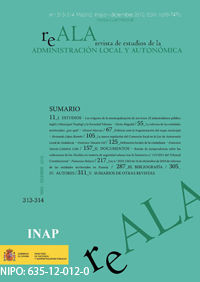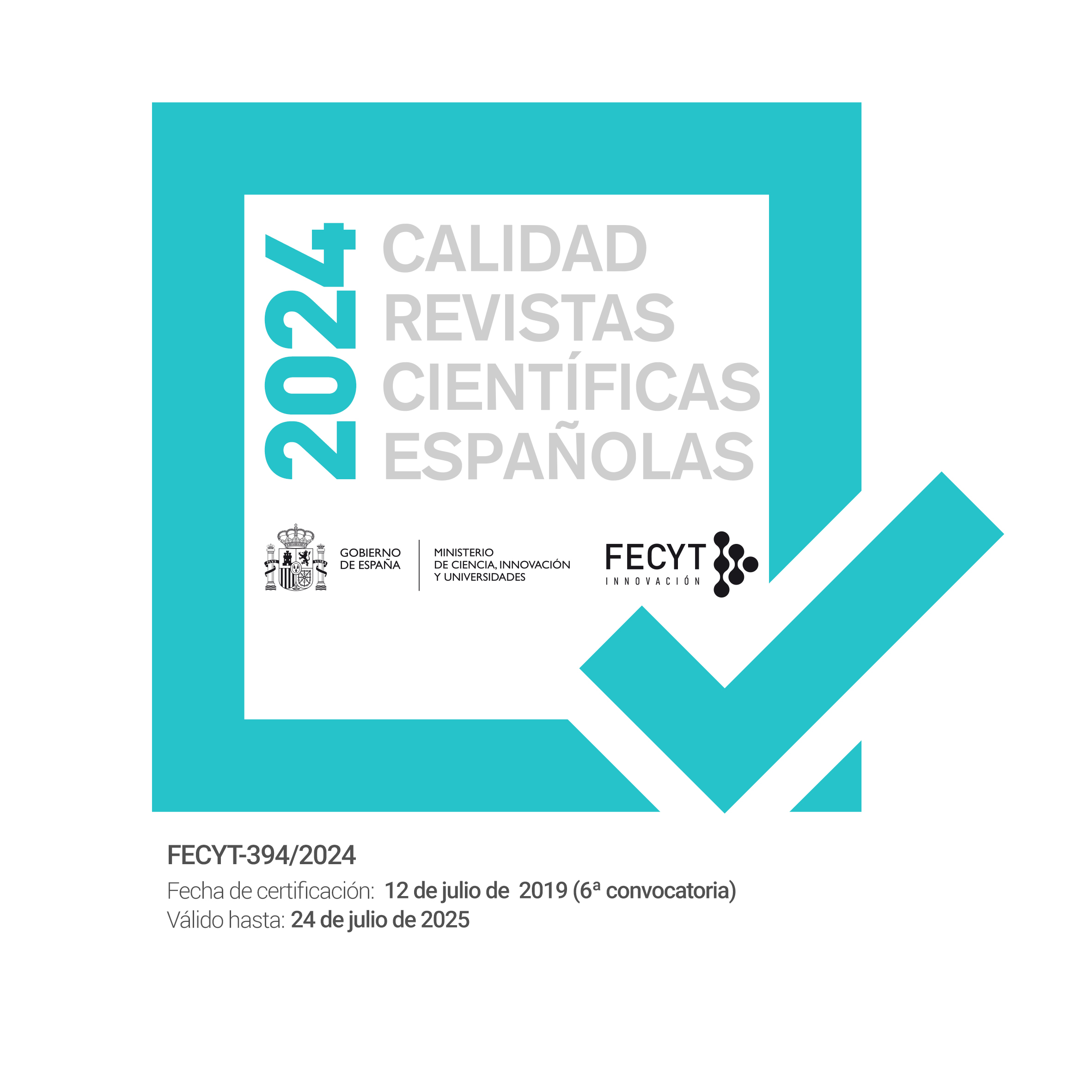Políticas ante la fragmentación del mapa municipal
DOI:
https://doi.org/10.24965/reala.vi313-314.9923Palabras clave:
Mapa municipal, pequeños municipios, fusiones de municipios, cooperación intermunicipal, comarcas, entes locales intermediosResumen
Partiendo de la notable fragmentación del mapa municipal español en el contexto europeo, se ofrecen elementos estadísticos, históricos y comparados que podrían proporcionar los siguientes criterios de reforma: 1) las diferencias existentes entre los mapas municipales de las Comunidades Autónomas justifican políticas no coincidentes; 2) el tamaño importa, de manera que, distanciándose tanto de posturas inmovilistas como de opciones por la movilidad constante en la organización territorial, cabría establecer un tamaño mínimo de los municipios en la legislación básica del Estado sin perjuicio del diseño de tamaños óptimos por las Comunidades Autónomas; 3) la cooperación intermunicipal como alternativa a las fusiones de municipios requiere esfuerzos sostenidos en el tiempo, y presenta notas de complejidad y de confusión de responsabilidades, según se advierte en el caso de Francia; 4) las fusiones municipales determinadas por fines de equilibrio territorial pueden ser más útiles que las establecidas por razones de eficiencia económica, tal y como ponen de relieve las experiencias europeas de Suecia, Dinamarca, Bélgica y Grecia; y 5) las comarcas como vía alternativa de solución del inframunicipalismo presentan limitaciones, aunque no habría de descartarse el empleo de mapas comarcales para constituir nuevos mapas municipales.
Descargas
Citas
Albi, Fernando (1966): La crisis del municipalismo, Madrid, IEAL, 514 pp.
Albrekt Larsen, Christian (2002): “Municipal size and democracy: a critical analysis of the argument of proximity base on the case of Denmark”, Scandinavian Political Studies, 25-4, pp. 317-332.
Aparicio Pérez, Miguel Ángel (2003): “Territorio y organización política”, J. Infante Díaz (ed.), Las comarcas de Aragón: territorio y futuro, Zaragoza, Gobierno de Aragón, pp. 143-155.
Burgueño, Jesús (2004): “El eterno debate sobre la reforma del mapa municipal. El caso de Cataluña”, Revista de Geografía, 3, pp. 7-33.
Casassas, Lluís y Clusa, Joaquim (1981): L’organització territorial de Catalunya, barcelona, Fundación Jaume Bofill, 326 pp.
Council of European Municipalities and Regions (2008): Balancing democracy, identity and efficiency. Changes in local and regional structures in Europe, Brussels, 94 pp.
Dahl, Robert A. (1971): “The city in the future of democracy”, American Political Science Review, 61, pp. 953-970.
Dahl, Robert A. y Tufte, Edward R. (1973): Size and democracy, Stanford University Press, 148 pp.
Dexia Reasearch Department (2008): Sub-national governments in the European Union. Organisation, responsibilities and finance, Dexia, 656 pp.
García Álvarez, Gerardo (2005): “Las comarcas”, J.M. Carbonero (dir.), La intermuni-cipalidad en España, Madrid, Ministerio de Administraciones Públicas, pp. 71-92.
Hermenier, Helen (2008): “The quest for perfect territorial organisation: comparison across Europe”, Council of European Municipalities and Regions: Balancing democracy, identity and efficiency. Changes in local and regional structures in Europe, Brussels, pp. 3-7.
Hertzog, Robert (2010): “Intermunicipal cooperation: a viable alternative to territorial amalgamation?”, P. Swianiewicz (editor), Territorial consolidation reforms in Europe, budapest, Open Society Institute, pp. 285-307.
Hlepas, Nikos (2010): “Uncompleted greek territorial consolidation: two waves of reforms”, P. Swianiewicz (editor), Territorial consolidation reforms in Europe, Budapest, Open Society Institute, pp. 45-74.
Houlberg, Kurt (2010): “Municipal size, economy, and democracy”, P. Swianiewicz (editor), Territorial consolidation reforms in Europe, Budapest, Open Society Ins-titute, pp. 309-331.
Illner, Michal (2003): “Procesos de descentralización y reformas en el gobierno de los países de Europa central y oriental”, Información Comercial Española, 809, pp. 117-134.
Izu belloso, Miguel J. (1999): “Democracia municipal ¿sin autonomía local?”, Diario de Noticias, 15 abril 1999.
Izu belloso, Miguel J. (2007): “El mapa local de Navarra”, Libro homenaje al profesor Francisco González Navarro. Organización y procedimiento administrativos, Thomson-Aranzadi, pp. 427-452.
Ladner, Andreas (2002): “Size and direct democracy at the local level: the case of Switzerland”, Environment and Planning C: Government and Policy, 20, pp. 813-828.
Loperena Rota, Demetrio (1988): “El mapa municipal ante la reforma del régimen lo-cal de Navarra”, Revista Jurídica de Navarra, 5, pp. 107-118.López Ramón, Fernando: “Los servicios públicos propios de la provincia”, R. Gómez-Ferrer (dir.): La provincia en el sistema constitucional, Madrid, Civitas, 1991, pp. 349-368.
Márquez Cruz, Guillermo (2010): “La desorganización administrativa en el Estado fragmentado”, R. Rodríguez González (director), Territorio. Ordenar para competir, La Coruña, Netbiblo, pp. 137-181.
Martín Mateo, Ramón (1964): La comarcalización de los pequeños municipios, Madrid, Ministerio de la Gobernación, 108 pp.
Meligrana, John, ed. (2004): Redrawing local government boundaries: an International study of politics, procedures and decisions, Washington, UbC Press, 246 pp.
Ministerio de Administraciones Públicas (2005): Libro blanco para la reforma del gobierno local, Madrid, 116 pp.
Morell Ocaña, Luis (1972): Estructuras locales y ordenación del espacio, Madrid, IEAL, 251 pp.
Nieto, Alejandro (2008): El desgobierno de lo público, Barcelona, Ariel, 392 pp.
Pop, Daniel (2005): “Municipality size and citizen’s effectiviness: Hungary, Poland and Romania”, G. Soós, V. Zentai (eds.), Faces of local democracy. Comparative papers from Central and Eastern Europe, Budapest, Kim Frazes, pp. 170-206.
Roca Junyent, Miquel, president (2000): Commissió d’experts. Informe sobre la revisió del model d’organització territorial de Catalunya, Departament de Governació y Relacions Institucionals, 125 + XXXIX pp.
Rodríguez González, Román (2005): Territorio y gobierno local en España, un planteamiento de reestructuración por fusión como realidad necesaria, Madrid, Civitas-Thomson, 162 pp.
Salanova Alcalde, Ramón, director (2002): La comarcalización de Aragón (II), Zaragoza, Cortes de Aragón, 254 pp.
Sánchez Blanco, Ángel (2006): Organización intermunicipal, Madrid, Iustel, 264 pp.
Sosa Wágner, Francisco y De Miguel García, Pedro (1987): Creación, supresión y alteración de términos municipales, Madrid, IEAL, 142 pp.
Swianiewicz, Pawel, editor (2010): Territorial consolidation reforms in Europe, Budapest, Open Society Institute, 341 pp.
Velasco Caballero, Francisco, director (2010): Gobiernos locales en Estados federales y descentralizados: Alemania, Italia y Reino Unido, Barcelona, Institut d’Estudis Autonòmics, 727 pp.
Warren, Mark E. (2001): “¿Qué puede significar hoy la participación democrática?”, Ramón Máiz (ed.), Contrucción de Europa, democracia y globalización, Servicio de Publicaciones de la Universidad de Santiago de Compostela, vol. I, pp. 67-87.
Wollmann, Hellmut (2008): “Decentralization and territorial local government reforms between local democracy and operacional efficiency. Some comparative observations and conclusions in the European context”, Council of European Municipalities and Regions, Balancing democracy, identity and efficiency. Changes in local and regional structures in Europe, Brussels, pp. 82-91.












